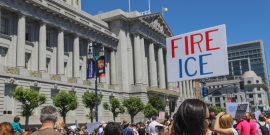Original methods originalism embeds the Constitution in the Anglo-American tradition and militates against the abstractions of the French philosophes.
A Limited Federal Government: Half Full or Half Empty?
One of the key features of the Constitution’s original meaning is that the federal government’s powers are limited. Unfortunately, the Supreme Court has allowed an enormous expansion of the federal government’s powers beginning especially during the New Deal. To an originalist and advocate of limited government, this is depressing. Yet, there is also a silver lining. The Supreme Court and apparently an influential part of the public continues to believe that the federal government’s power is limited. The Court has been willing to enforce this principle of limited federal powers, although in a significantly weakened form.
The limited character of the federal government under the Constitution’s original meaning seems clear to me. It has roots in the constitutional text and in discussions of the Constitution at the time of its enactment. Consider first the text: The Legislative Vesting Clause of Article I, section 1 provides that “All legislative powers herein granted shall be vested in a Congress.” And the Constitution in various part, especially Article I, Section 8, provides a list of powers that Congress has. The obvious import, which had been recognized widely at the time of the Constitution is that this enumeration implies that other unenumerated powers are not conferred. The Tenth Amendment provides additional support for this conclusion.
Discussions at the time of the Constitution’s enactment reinforce this textual discussion. For example, the Federalists, who advocated ratification of the Constitution, defended it against the charge that it did not include a bill of rights, based on the idea that the federal government’s powers were limited and therefore could not abridge various rights, including freedom of the press.
Yet, our constitutional history often ignored these truths. Beginning with the New Deal Court and continuing until 1995, the Supreme Court never struck something down a law as exceeding the enumerated powers (except in the limited instance when it interfered with state government powers). To me, this has been one of the tragedies of our constitutional history.
Yet despite this tragedy, the currrent Supreme Court and apparently the public have not accepted this change. There are at least two significant pieces of evidence for this conclusion. First, even during the years prior to 1995, the Court never admitted that they were failing to enforce the limits on Congress’s powers. Instead, they had a bunch of doctrines that allowed the Congress to do anything it liked, but without admitting this. These doctrines included a broad Commerce Clause and Necessary and Proper Clause interpretation, the aggregation doctrine and rational basis test of Congress’s factual findings or assumptions. Thus, insider lawyers understood, but those outside did not. (Each year my students need to be told what was going on, since it is not evident from the cases.)
Second, since 1995, a key factor in Supreme Court cases has been whether the theory necessary to justify a broad federal law, such as the Affordable Care Act, would still limit the federal government’s powers. If the theory would not limit Congress’s powers in some way, then five members of the Supreme Court have often been willing to strike down the law on Commerce Clause grounds, including in Lopez, Morrison and Sebelius.
So where are we on the enumerated powers? The Supreme Court’s doctrine is much weaker than the original meaning, but the Court still believes in some limitation, much to the chagrin of many progressive constitutional law professors.



